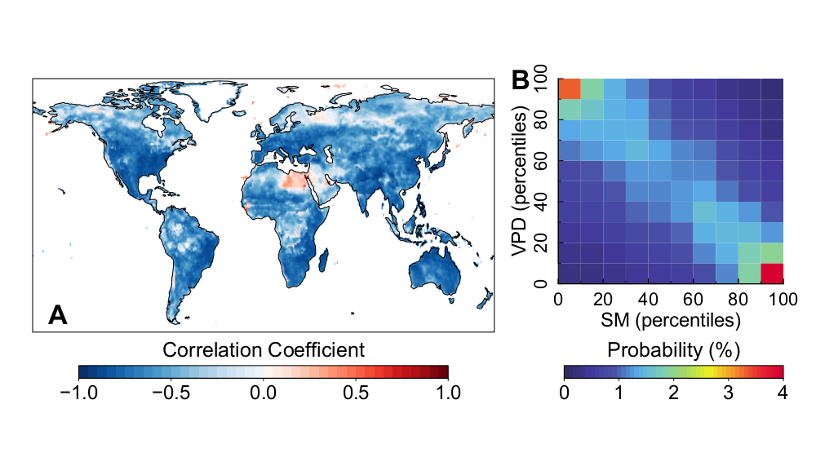New Feedback Phenomenon Found to Drive Increasing Drought and Aridity
New study shows an increasingly high probability of more frequent, more extreme concurrent soil drought and atmospheric aridity, intensified by both climate change and land-atmosphere processes, posing large risks to the planet and human life
Media Contact
Holly Evarts, Director of Strategic Communications and Media Relations
212-854-3206 (o), 347-453-7408 (c), [email protected]
Journal
Proceedings of the National Academy of Sciences (PNAS)
About the Study
The study is titled “Land-atmosphere feedbacks exacerbate concurrent soil drought and atmospheric aridity.”
Authors are: Sha Zhou1,2,3*, A. Park Williams1, Alexis M. Berg4, Benjamin I. Cook1,5, Yao Zhang3, Stefan Hagemann6, Ruth Lorenz7, Sonia I. Seneviratne7, Pierre Gentine2,3.
1 Lamont-Doherty Earth Observatory of Columbia University
2 Earth Institute, Columbia University
3 Department of Earth and Environmental Engineering, Columbia Engineering
4 Department of Civil and Environmental Engineering, Princeton University
5 NASA Goddard Institute for Space Studies
6 Helmholtz-Zentrum Geesthacht, Institute of Coastal Research, Germany
7 Institute for Atmospheric and Climate Science, ETH Zurich
The study was supported by NASA ROSES Terrestrial hydrology (NNH17ZDA00IN-THP) and NOAA MAPP NA17OAR4310127 (PG); NASA Modeling, Analysis, and Prediction (MAP) program (NASA 80NSSC17K0265) and Columbia University’s Center for Climate and Life (A.P.W. and B.I.C.).
The authors declare no financial or other conflicts of interest.

Global coupling of soil drought (SM) and vapor pressure deficit (VPD).
New York, NY—September 2, 2019—A new Columbia Engineering study indicates that in the coming century the world will experience more frequent and more extreme drought and aridity than are being currently experienced, exacerbated by both climate change and land-atmosphere processes. The researchers demonstrate that concurrent soil drought and atmospheric aridity are largely driven by a series of land-atmosphere processes and feedback loops. They also found that land-atmosphere feedbacks would further intensify concurrent soil drought and atmospheric aridity in a warmer climate. The study was published today in Proceedings of the National Academy of Sciences (PNAS).
While earlier studies have looked at how atmospheric and oceanic processes drive climate extremes, the Columbia Engineering team has focused on examining and modeling land-atmosphere processes, especially in setting up concurrent extremes that can be very destructive. Soil drought, represented by very low soil moisture, and atmospheric aridity, represented by very high vapor pressure deficit (a combination of high temperature and low atmospheric humidity), are the two main stressors that drive widespread vegetation mortality and reduced terrestrial carbon uptake. Concurrent soil drought and atmospheric aridity is a time period when soil moisture is extremely low and vapor pressure deficit is extremely high.
“Concurrent soil drought and atmospheric aridity have dramatic impacts on natural vegetation, agriculture, industry, and public health,” says Pierre Gentine, associate professor of earth and environmental engineering and affiliated with the Earth Institute. “Future intensification of concurrent soil drought and atmospheric aridity would be disastrous for ecosystems and greatly impact all aspects of our lives.”
The researchers combined reanalysis datasets and model experiments to identify the main land-atmosphere processes leading to concurrent soil drought and atmospheric aridity, and used climate models and statistical methods to assess how land-atmosphere processes would impact the frequency and intensity of concurrent soil drought and atmospheric aridity in future climate. The challenge they faced was how to isolate the impact of land-atmosphere feedbacks on concurrent drought and aridity. After trying many different methods, they worked with the GLACE-CMIP5 (Global Land Atmosphere Coupling Experiment—Coupled Model Intercomparison Project) scientists at ETH Zurich’s Institute for Atmospheric and Climate Science and used their model experiments.
Gentine’s group is the first to isolate this phenomenon and were surprised their work produced such dramatic findings.
“Most groups have been focused on assessing concurrent drought and heatwaves, but we are finding stronger coupling between drought and aridity than between drought and heatwaves,” says Sha Zhou, the study’s lead author and a postdoc working with Gentine. “Concurrent drought and aridity also have a stronger impact on the carbon cycle and so we felt this was a critical point to study.”
The team discovered that the feedback of soil drought on the atmosphere is largely responsible for increasing the frequency and intensity of atmospheric aridity. In addition, the soil moisture-precipitation feedback contributes to more frequent extreme low precipitation and soil moisture conditions in most regions. These feedback loops lead to a high probability of concurrent soil drought and extreme aridity. The CMIP5 simulations suggest that land-atmosphere feedbacks will further increase the frequency and intensity of concurrent drought and aridity in the 21st century, with potentially large human and ecological impacts.
The PNAS study highlights the importance of soil moisture variability in enabling a series of processes and feedback loops affecting the Earth’s near-surface climate.
Says Gentine, “It’s critical that we better quantify and evaluate the representation of these processes in our climate models. Accurate model representation of both soil moisture variability and the associated feedbacks is crucial if we are to provide reliable simulations of the frequency, duration, and intensity of compound drought and aridity events and of their changes in a warmer climate. Ultimately, this will help us mitigate future risks associated with these events.”
###
Columbia Engineering
Columbia Engineering, based in New York City, is one of the top engineering schools in the U.S. and one of the oldest in the nation. Also known as The Fu Foundation School of Engineering and Applied Science, the School expands knowledge and advances technology through the pioneering research of its more than 220 faculty, while educating undergraduate and graduate students in a collaborative environment to become leaders informed by a firm foundation in engineering. The School’s faculty are at the center of the University’s cross-disciplinary research, contributing to the Data Science Institute, Earth Institute, Zuckerman Mind Brain Behavior Institute, Precision Medicine Initiative, and the Columbia Nano Initiative. Guided by its strategic vision, “Columbia Engineering for Humanity,” the School aims to translate ideas into innovations that foster a sustainable, healthy, secure, connected, and creative humanity.
